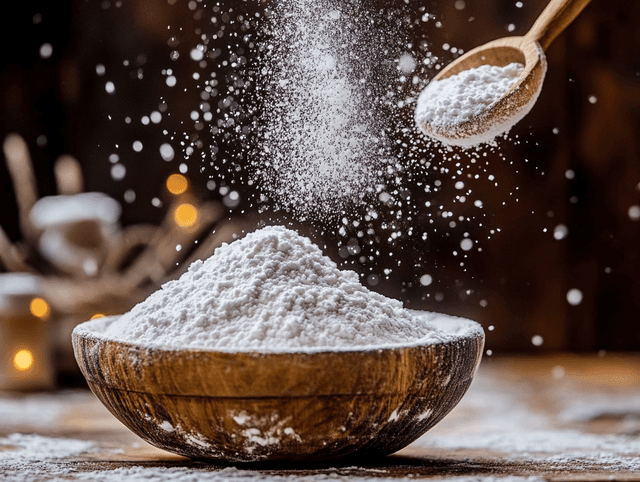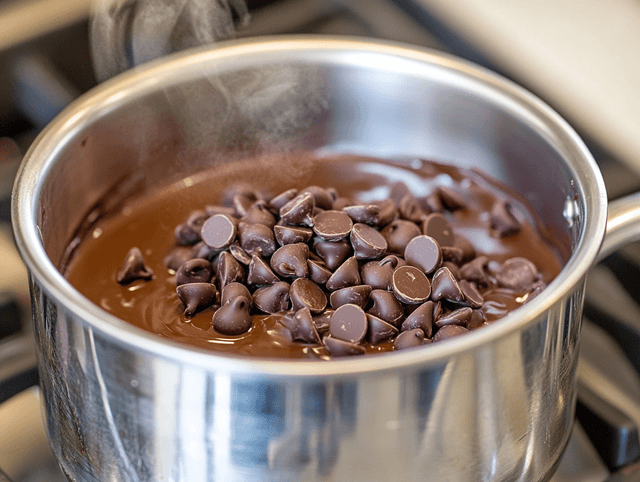What is self-rising flour and what is it used for?
Self-rising flour is a type of flour that already comes mixed with a leavening agent, usually baking powder, and a pinch of salt. This means that when you use it for baking, you don't need to add any additional yeast. It's ideal for quick recipes like cakes, cookies, and pancakes, where you want the dough to rise without complications. The magic lies in how it saves you time and steps in the kitchen.
It is mainly used in recipes that require a quick and uniform rise. Self-rising flour is perfect for those who seek simplicity and speed without sacrificing flavor or texture. Since it already has baking powder incorporated, it guarantees that your baked goods will have a light and fluffy texture. So, if you're looking to make a quick cake or some cookies without much hassle, this flour is your best ally.

Differences between self-rising flour and all-purpose flour
Before delving into the differences between self-rising flour and all-purpose flour, it's important to understand that both have specific uses in the kitchen. Although they may seem similar, their composition and applications in recipes vary significantly:
- Composition: Self-rising flour includes baking powder and salt, which allows doughs to rise without needing additional yeast. In contrast, all-purpose flour is simply milled wheat without leavening agents, giving you complete control over the ingredients you wish to add for rising.
- Uses: Self-rising flour is ideal for quick recipes like cakes, cookies, and pancakes, where an immediate rise is needed. All-purpose flour is more versatile and used in a wide variety of recipes, from breads to sauces, as you can adjust the leavening agents as necessary.
- Convenience: Using self-rising flour simplifies the baking process by eliminating the step of measuring and adding baking powder and salt. This is especially useful for novice cooks or when speed is desired. All-purpose flour requires you to add these ingredients separately, which can be preferable for recipes that require precision.
- Control: With all-purpose flour, you can adjust the amount of baking powder or yeast according to your specific needs, which is crucial in recipes that demand precision in leavening. This is not possible with self-rising flour since the proportions are predefined.
- Availability and Cost: All-purpose flour tends to be more available and generally more economical. This makes it a popular choice for those who cook regularly and prefer greater control over their ingredients. Self-rising flour can be more expensive due to its pre-mixed convenience.

The role of baking powder in self-rising flour
Baking powder is the ingredient that turns self-rising flour into a quick and efficient solution for baking. Its presence in the mix allows doughs to rise without additional complications, making the baking process more accessible for everyone.
- Pre-mixed Composition: Self-rising flour already contains baking powder, which eliminates the need to add it separately in recipes. This not only saves time but also reduces the margin of error when measuring ingredients.
- Quick Leavening: Thanks to the baking powder, doughs can rise quickly when mixed with liquids and heated in the oven. This helps create a light and fluffy texture in products like cakes and cookies.
- Consistency in Recipes: Having baking powder pre-mixed ensures an even distribution of the leavening agent throughout the dough. This guarantees that baked goods rise evenly, avoiding dense or undercooked areas.
- Ideal for Simple Recipes: Self-rising flour is perfect for quick recipes where prolonged fermentation or resting time is not required. This includes preparations like pancakes and muffins, where speed is key.
- Facilitates the Baking Process: Especially useful for beginner cooks or those seeking speed in the kitchen, self-rising flour allows for consistent results without sacrificing the quality of the final product.

Ingredients Needed to Make Self-Rising Flour
To prepare self-rising flour at home, you only need a few basic ingredients that you probably already have in your kitchen. This mix will allow you to always have a quick and efficient option for your baking recipes.
- All-Purpose Flour: The base of self-rising flour is regular wheat flour. You will need 1 cup (approximately 125 grams) to start the mix.
- Baking Powder: This is the leavening agent that allows the dough to rise. Add 1 1/2 teaspoons (approximately 7 grams) to the flour.
- Salt: Salt is added to balance the flavors and improve the texture. You will need 1/4 to 1/2 teaspoon (approximately 2 to 3 grams).
With these ingredients, you can create your own self-rising flour simply by mixing them well. Be sure to store the mix in an airtight container to keep it fresh and ready to use when needed.

How to Make Self-Rising Flour
Making self-rising flour at home is a very simple process that only requires three basic ingredients. Below, I explain step-by-step how to prepare it and some useful tips to achieve the best results.
Step-by-Step Instructions:
- Measure the Flour: In a large bowl, place 1 cup (125 grams) of all-purpose flour. Make sure to level the measurement with a spatula or knife for accuracy.
- Add the Baking Powder: To the cup of flour, add 1 ½ teaspoons (7 grams) of baking powder. This is the leavening agent that will make your baked goods rise.
- Incorporate the Salt: Add ¼ teaspoon (1 gram) of salt to the mixture. Salt not only enhances flavor but also helps balance the ingredients.
- Mix Well: Using a whisk or spoon, mix all the ingredients thoroughly until they are completely combined. Ensure that the baking powder and salt are evenly distributed throughout the flour.
- Store Properly: If you are not going to use the mixture immediately, store it in an airtight container in a cool, dry place. This will help maintain the freshness and effectiveness of the baking powder.
Tips for Best Results:
- Use Fresh Flour: Ensure that the flour you use is fresh and free from strange odors or signs of moisture, as this can affect the performance of the baking powder.
- Sift the Ingredients: If you want to ensure that all ingredients are perfectly combined and avoid lumps, you can sift the mixture two or three times.
- Test the Baking Powder: If your baking powder has been stored for a long time, test its effectiveness before using it. You can do this by mixing a small amount with hot water; if it bubbles immediately, it is in good condition.
- Make Small Quantities as Needed: Although you can make large batches, it's advisable to prepare only what you need to prevent the baking powder from losing its potency over time.
With these steps and tips, you'll always have homemade self-rising flour ready to use in your favorite recipes without needing to buy it from the supermarket.

Common Uses of Self-Rising Flour in Homemade Recipes
Self-rising flour is a versatile ingredient widely used in baking due to its ability to simplify the baking process. Here are some of the most common uses of this flour in homemade recipes:
- Cakes and Pastries: Self-rising flour is ideal for making cakes and pastries, such as the classic vanilla sponge cake. Its ability to provide uniform rise and a fluffy texture makes it perfect for these preparations.
- Pancakes: This flour is excellent for preparing light and fluffy pancakes, as it facilitates quick rising without the need for additional yeast. You can enjoy pancakes with various toppings like syrup, fruits, or nuts.
- Muffins and Cupcakes: Chocolate or vanilla muffins are another treat that benefits from using self-rising flour. The mix ensures that muffins have a tender and well-developed crumb, perfect for breakfasts or snacks.
- Cookies: For soft and slightly crispy cookies, self-rising flour provides the perfect balance between texture and flavor, eliminating the need to measure leavening agents separately.
- Quick Breads: In recipes for quick breads like soda bread, self-rising flour offers a quick and effective solution to achieve good volume without prolonged fermentation times.
These uses demonstrate the convenience and effectiveness of self-rising flour in a variety of homemade recipes, making baking more accessible for both beginners and experienced bakers.

Benefits of Using Homemade Self-Rising Flour in the Kitchen
Homemade self-rising flour offers multiple advantages for those who enjoy baking and want greater control over their ingredients. Here are some of the most notable benefits:
- Control Over Ingredients: By making your own self-rising flour, you can adjust the proportions of baking powder and salt according to your preferences or dietary needs. This is especially useful if you aim to reduce sodium content or prefer using organic ingredients.
- Guaranteed Freshness: Preparing self-rising flour at home ensures that the baking powder is always fresh, which is crucial for achieving a good rise in your baked goods. Fresh ingredients guarantee better texture and flavor in your recipes.
- Cost Savings: Buying the ingredients separately and mixing them yourself can be more economical in the long run, especially if you already have flour and baking powder at home. This also eliminates the need to purchase different types of flour for each recipe.
- Versatility in the Kitchen: Homemade self-rising flour can be adapted to a variety of recipes, from cakes to pancakes, without needing to adjust other ingredients. This simplifies the baking process and allows for experimentation with new recipes.
- Reduction of Waste: By preparing only the amount needed for each recipe, you reduce ingredient waste and prevent the baking powder from losing its effectiveness over time.
These benefits make homemade self-rising flour an attractive option for any cooking enthusiast seeking practicality without sacrificing quality.

How to Properly Store Self-Rising Flour
Storing self-rising flour correctly is crucial to maintaining its freshness and effectiveness, especially since it contains baking powder, which can lose potency over time if not stored well. Here are some tips to ensure your self-rising flour is always ready to use:
- Use an Airtight Container: Store the self-rising flour in an airtight container to protect it from moisture and air. This helps prevent the baking powder from losing its leavening ability.
- Store in a Cool, Dry Place: Keep the container in a cool, dry place, away from heat sources or direct sunlight. Humidity and heat can negatively affect both the flour and the baking powder.
- Avoid Cross-Contamination: Make sure to use clean, dry utensils when scooping flour from the container. This will prevent moisture or residues from other ingredients from contaminating the mix.
- Label with Date: If you prepare your own self-rising flour, label the container with the preparation date. This will help you keep track of its freshness and use it within an optimal period.
- Check Regularly: Before using, check for signs of moisture or clumps, which could indicate it has absorbed moisture. If you notice any issues, it's best to prepare a new batch.
By following these tips, you can ensure that your self-rising flour stays in perfect condition, ready to provide the best results in your homemade recipes.

Frequently Asked Questions (FAQs)
Q: How can I make self-rising flour if I don't have baking powder?
A: You can use baking soda and an acid like cream of tartar to create a similar effect to baking powder, although the result may vary slightly.
Q: Is self-rising flour suitable for all baking recipes?
A: No, self-rising flour is best for recipes that require a quick rise, such as cakes and cookies, but it is not ideal for breads that need prolonged fermentation.
Q: Can I use self-rising flour in recipes that require yeast?
A: It is not recommended, as yeast and baking powder work differently. Using both can alter the texture and flavor of the final product.
Q: How does altitude affect self-rising flour?
A: At high altitudes, it is recommended to reduce the amount of baking powder in self-rising flour to prevent baked goods from rising too quickly and collapsing.










